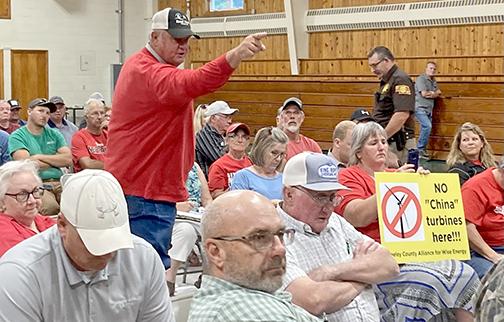Issues include public safety, China, economic opportunity
GREELEY, Neb. – Better to walk out than get thrown out.
And with that, Robert Bernt, an organic farmer in central Nebraska, turned and left the old school gymnasium where the county zoning board was evaluating a proposed wind farm.
“Silver-tongued” and “corrupt” were some of the allegations he’d leveled at the Greeley County officials in that tense June meeting. The project was being sought by area farmers who viewed it as a way to shore up their family incomes and feed tax revenue into local schools and government.
Most of the several dozen people in attendance shared Bernt’s anger. They accused local officials of aiding China, a major player in renewables, and jeopardizing neighbors’ health and property values. And they disputed the project’s promised economic benefits. One opponent called on the group to join him in prayer as he beseeched God to steer officials away from the plan. Most stood with him.
An epic and consequential battle is unfolding in Nebraska over renewable energy. From the Panhandle to the state’s eastern edge, people have packed local meetings, filed lawsuits and flexed political power.
It’s a high-stakes fight, with property rights, the character and economic well-being of rural Nebraska and health of the planet all at play.
Beyond those other concerns, opponents have long worried about the changes turbines bring to the state’s scenic skies and the intermittent nature of renewable energy.
“My bottom line, the alliance’s bottom line, is to protect public safety,” Bernt said by phone, referencing the Facebook group he is a member of, the Greeley County Alliance for Wise Energy.
Scientists say fossil fuels must be replaced quickly because human activity has increased the amount of heat-trapping gasses in Earth’s atmosphere to their highest levels in at least 3 million years. Waiting for the consequences of that hotter, more energetic atmosphere to fully play out before acting will be devastating, they say.
Since the 1980s, Nebraska has seen a six-fold increase in $1 billion-plus weather disasters that affect the state, according to federal weather data. Worsening disasters lie ahead, the state’s own scientists have said.
Billions of federal dollars are available to assist with the nationwide energy transition, and Nebraska communities are well poised to tap that money, said John Hansen, president of the Nebraska Farmers Union. Nationally, the state ranks in the top five for wind power potential and top 15 for solar potential.
Instead, a half dozen Nebraska counties have enacted some of the nation’s strictest zoning regulations, said Matthew Eisenson, an attorney in the Sabin Center for Climate Change Law at New York’s Columbia University.
Most of those are targeted at wind, which has seen the most growth in the state and now provides almost one-third of Nebraska’s electricity. (The Omaha Public Power District credited wind energy with helping keep the lights on when January’s bitter cold forced it to shut down its coal plants.)
Stanton County has effectively banned wind turbines in its regulations, according to the Sabin Center.
Wheeler and Buffalo counties have a 5-mile distance – or setback – between turbines and certain types of property.
Dawson and Thomas counties have added a 3-mile setback.
Using 3 miles as an example, Eisenson said a farmer who wants to erect a wind turbine would need more than 36 square miles of land – an area more than twice the size of Kearney – to create that buffer zone.
“You need to have massive tracts of land to even install a single turbine,” he said.
The restrictions and similar actions appear to have derailed some wind projects, including in Dawson, Gage and Butler counties.
NextEra Energy Resources, the world’s largest developer of wind and solar projects, said it has already invested about $814 million in Nebraska and remains committed to continuing despite the opposition. That includes in Greeley County, where it’s developing the proposed wind farm.
“We … believe that well-sited projects can provide significant benefits to the counties where they are built,” NextEra told the Flatwater Free Press.
Industrial scale solar projects are moving forward despite opposition in Cass, Saunders and Lancaster counties.
In some communities, opposition has led to lawsuits, including in Lancaster, Saline and Webster counties. A Cherry County case filed by opponents of a wind project went all the way to the Nebraska Supreme Court before being thrown out.
George Johnson, the Cherry County planning board chairman who found himself and family at the center of the controversy said he resigned over the vitriol.
“It got so out of hand,” he said. “There were just one or two people who were, pardon my language, bat**** crazy. They would not listen to facts.”
Hansen said the issue has become so fraught that Nebraska communities are losing their ability to compromise.
“We are no longer having people of good will coming together to protect our public health and safety,” he said. “The goal of the opposition is to come up with regulations that will kill projects. By doing so, they take away their neighbors’ rights.”
Meetings in Greeley County became so crowded and so combative that the county moved them from a small room at the courthouse to an old school gymnasium.
“(Opponents) were very angry and were using physical closeness and aggression,” Greeley County Attorney Cindy Bassett said. “We had people shouting and screaming, coming up to the table. … They were in county governmental personnel’s faces.”
Advocates of the Greeley project, including local landowners, had worked 15 years to bring it to fruition. They talked at that June meeting about how they hoped the revenue would help their local schools, keep the center pivots running and make farming more sustainable.
“We ought to be able to market this product just as any other person markets a product they grow on their land,” landowner Brian Gydesen said.
County officials worked for about three years to craft regulations to govern renewable energy, Bassett said. Those meetings were publicized and open to the public.
“Not a single person showed up – ever,” she said.
The project only became contentious in the last year or so after the zoning rules were written and the planning commission recommended NextEra’s application to the county board.
Much of the opposition’s concerns mirrored arguments made in other communities.
Bernt and others said they believe there are health effects from the noise, vibrations and flickering shadows generated by wind turbines, and environmental risks from the concrete bases and decommissioned blades.
Some asked if turbines could change the weather or would harm endangered species. They worried the turbines would lower property values and affect farm income by limiting aerial spraying. They also worried about damage to roads and taxpayers being left to pay decommissioning costs if the developer abandoned the turbines.
Studies have found that the impact on health and property values tends to correlate to local attitudes. The more opposed a community is to wind, for example, the more likely property values are affected. Likewise, the severity of health effects seem to correlate to a person’s feelings about wind turbines along with their ability to see and hear them.
China also has become an argument, with opponents keying in on the country’s dominance in renewables manufacturing, its own dirty energy practices and even the possibility it would use turbines to spy on America.
“What’s to stop Red China from putting monitoring devices, and devices to disrupt communications, atop the towers?” Mike Conley asked at the Greeley County meeting. “Absolutely nothing.”
The backlash to renewable energy comes at a cost, Hansen said. Renewable energy is poised to become the largest source of good paying jobs in rural Nebraska while generating income for some landowners and building a new tax base.
“Opportunity only knocks at the door so many times. ... All we have to do is say ‘yes.’”
Based on public and private data, he estimates that commercial scale wind power already generates more than $17 million in landowner income and $17 million in tax revenue in Nebraska. Those projects, he said, have added $6.1 billion to the state’s tax base, slightly more than ethanol plants.
“These folks are thumbing their noses at their child’s future,“ Hansen said of the opposition.
Nebraska isn’t an outlier. Across the U.S. – and in other countries – the transition to cleaner energy is being met with increasing pushback.
Some supporters of renewable energy suspect that outside interests are driving the local opposition. They point to articles by national opponents posted on local Facebook pages, local opposition groups appearing at meetings in matching T-shirts, opponents traveling across the state to encourage opposition and some national figures coming to Nebraska.
“It’s money, it’s resources, all in the background, it’s in the dark,” said David Levy, an Omaha-based attorney for renewable energy developers. “Nobody is admitting that they are getting resources, getting encouraged or being paid by groups, but I believe that’s what’s happening.”
Bernt and others, like Emily Haxby, a Gage County supervisor who worked to enact strict zoning rules in her county, dismiss those claims.
“There was no outside influence here,” Haxby. “Our community just came together.”
Haxby said it’s not fair for one property owner to make money off a wind or solar farm if their neighbor experiences harm without being included in the process.
“We need to have regulations that allow community decisions,” she said.
Opponents have used social media, notably Facebook, to form local groups to fight projects, including: Stop K-Junction Solar, Stop Hallam Wind, Our Voices Count, Nebraska Wind Watchers and McCool Junction Responsible Solar.
Nationally, opposition to renewable energy is fueled by a mix of disinformation and vested interests trying to block progress, said David Anderson, a spokesman for the Energy and Policy Institute, a renewable energy watchdog organization.
Some of that information, he said, originates from national blogs, state groups and media outlets. Some of it is organic. It’s not unusual, he said, to see groups that “cut and paste reports that exaggerate the cost of renewable energy policies.”
Two national advocates of fossil fuels brought their message to Nebraska last year: Daniel Turner and Robert Bryce. Both have had ties to think tanks that receive funding from the oil industry. A third national figure, John Droz Jr., an outspoken opponent of renewable energy, contributed heavily to an analysis opposing a wind project in Jefferson County.
Turner, executive director of Power The Future, spoke in Greeley County after being recruited by resident Trevor Nekoliczak, who heard Turner on a podcast. Nekoliczak said he wanted a counterpoint to the wind developers.
“You can find a lot of information, it’s just whether you trust that information. Who to trust – that has been a long journey for me,” Nekoliczak said. “It’s still up in the air, trust no one, and verify everything.”
Turner told the Flatwater Free Press that he traveled to Nebraska at the expense of his organization. He said he encouraged people to know their rights before signing a lease.
“People are longing for clarity and I offer clarity,” he said.
Ultimately, opposition didn’t stop the NextEra project in Greeley County.
Still, Bernt takes pride in what he sees as precedent-setting conditions: the wind developer must provide decommissioning and road repair funds upfront.
Bassett, the county attorney, said NextEra will have to put $12 million for decommissioning and $5 million for road repairs into an escrow account. Any interest will accrue to the county.
“It was the strong conviction of the county commission that we didn’t want to be left holding the bag if something happens,” she said.
Greeley County, like several other Nebraska counties, has instituted a moratorium on all new renewable energy projects while it revisits its zoning regulations.
NextEra says the project outside of Greeley will include up to 41 turbines, and generate $19 million in tax revenue and $27 million in landowner income over its 30-year lifespan.
Bassett said she believes Nebraskans need to “take a breather” and figure out how to work through divisive issues. Other forms of energy will become flash points at the local level, including nuclear power, hydro and geothermal, she said.
“I’ve been doing this 25 years and I’ve never seen anything like this,” Bassett said. “We absolutely need a better way of talking about this … because more conflict lies ahead.”
This article was written by Nancy Gaarder for Flatwater Free Press. The Flatwater Free Press is Nebraska’s first independent, nonprofit newsroom focused on investigations and feature stories that matter.





